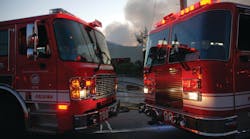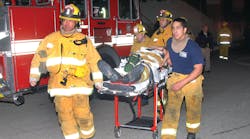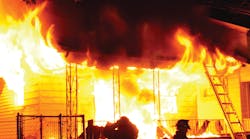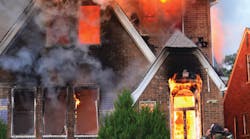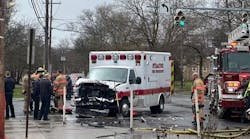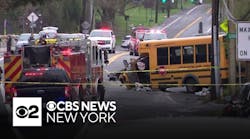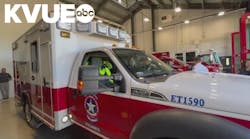These questions get to the heart of the fire department’s efficiency. Set aside for a moment that it is extremely difficult to predict when an emergency will occur. On-duty staffing serves, in some respects, as an insurance policy for businesses, citizens and visitors to your town. And while many businesses and individuals pay for insurance, few think they are ever going to actually use the benefits contained in their policy. They are, however, very happy to know the policy was there to protect them when a loss occurs.
The fire department is very similar to an insurance policy in the minds of some citizens and elected officials. They don’t like paying for first responders to be on duty and appearing to be non-productive (not handling emergency calls). In some respects, this is understandable. All employers want productive employees and they surely don’t want employees who can sit idle for extended periods, cook and eat on company time – even sleep on company time. And citizens don’t want their hard-earned tax dollars being spent for workers to sit idle. This can lead to some fire departments being criticized for having seemingly large amounts of idle time and the seemingly non-productive use of that idle time.
On-duty fire and EMS personnel are on-duty for a reason – to provide a quick response to critical emergencies in hopes of keeping a bad situation from becoming worse or to prevent an unfortunate event from becoming a tragedy. The decision to have on-duty personnel is one made by elected officials as they are charged with being the stewards of their community’s public funds. If, in their wisdom, the funds are wisely spent having ready responders on duty, then fire and EMS are funded to ensure so.
On-duty first responders in some communities are very busy – answering 15 to 20 emergency calls (or more) in a 24-hour period. Others are not so busy – answering three to five emergency calls (or fewer) in a 24-hour period. The question is how much down time do the on-duty responders have and what is the right size for the response force?
Down time
The down-time component of the question is easier to answer than the right size of the response force. The amount of time committed to emergency calls, house duties, training, administrative duties, prevention, fitness, resting, etc., can, and should, be tracked. The only way to know how busy you are is to measure it. And not just your committed time, but what your personnel are doing during their committed time. This data can help paint a clear picture of efficiency.
The results of tracking and measuring productive time can be complimentary of the department’s efficiency or it can point out some opportunities for improvement. For example, if the committed time to all activities averaged eight to 12 hours during a 24-hour shift, then one could make a reasonable argument that the personnel are being used efficiently, with consideration for time for breaks, meals and rest. If, however, the committed time averaged three to six hours in a 24-hour operational period, then one could surmise there are opportunities for greater utilization of staff time in productive activities that advance the mission of the fire department or in support of the mission of other departments in the city.
Measuring productive time is no less important for those volunteer agencies that use a duty-schedule-type program for their volunteer firefighters. These programs will typically allow members of the volunteer workforce to schedule their own time to work on-call (on-shift) duties. This satisfies the commitment requirement of the volunteer while ensuring a predictable response.
The chart illustrates a “typical” day for a volunteer firefighter staffed station program.
If you do an efficiency study, it is important the records are accurate and realistic. Listing five hours per day for training every shift may not be realistic nor accurately reflect what is happening. Two hours a day to clean the station isn’t realistic either, unless you have a massive station or very messy people.
The time needed to perform many of the department’s activities and duties are, in fact, predictable and relatively stable. The time needed to clean, perform equipment checks, cook and eat meals, and conduct daily training and public education are examples of a workload whose time commitments are relatively stable and predictable. Even the time to handle most EMS calls and many of the fire-related calls is predictable within a range.
What is not predictable are the most critical and time-consuming calls for service, like rescues, structure fires and extrications. It is impossible to program for these and when they happen, it’s going to set off a chain reaction that will impact all of the scheduled activities for the shift. A house fire, for example, can easily last two hours with an additional two hours for cleanup and getting all the equipment and apparatus back in service. Such events will have a four-hour impact on other scheduled activities. As well, the physical demands of a working fire or a rescue may also warrant a rest period for personnel to allow for physical and mental rejuvenation.
It is also unrealistic to expect first responders to remain physically engaged in programmed work-related activities for extended periods (beyond 10 to 12 hours). First responders need to be rested and prepared for the physical and mental demands of their high-stress, high-consequence work. Responders may get only one chance to get something right – be that a decision at an emergency scene or a medication calculation for a critically ill patient. Physical and mental rest is important in this line of work.
The argument for being physically and mentally rested noted, many organizations still have opportunities for greater utilization of personnel time. In fact, personnel in some departments have become – putting it bluntly – lazy. And it is such laziness that leads to more scrutiny of the efficiency of operations.
Track what personnel do and how much time they spend doing it, then ask yourself the hard questions about the essential nature of that work. Is it busywork or is it productive work that advances the department’s mission. Are personnel being kept engaged in activities that advance the mission at least eight hours of the shift?
Work schedules
Many fire departments staff the same number of personnel around the clock. However, statistically speaking, the volume of emergency calls probably follows a predictable pattern that reveals different times of the day and night and different days of the week are busier than others. This is where critics can challenge staffing models. Let’s say you have 40 on-duty, response-ready personnel for fire and medical emergencies in your community. Further, let’s assume your call volume is busiest from 7 A.M. until 9 P.M. and then it tails off significantly. Your community’s call experience may mimic this example or it may be very different, but be assured there is likely a distinctive pattern for emergency responses.
Critics of consistent-staffing models may argue it would be wiser to staff up for periods when call volumes are predictably higher and then staff downward for periods when call volumes are predictably lower. Fundamentally, this makes sense. However, the fire department needs to have a solid “Plan B” in place for those anomalies – those times when the moons and stars align and the call volumes are far above expectation. While this can happen at any time, it’s not likely to happen all the time. If it did all the time, it would change the pattern and predictability curves for call volume.
Staffing levels
It is not realistic or financially feasible for most communities to have enough staffing on-duty to adequately handle worst-case scenarios 24 hours a day. In fact, only the very largest metropolitan departments may be able to ensure that level of resource availability. For the rest of us, the goal should be to staff for the typical and predictable call volumes and workload demands and have a solid call-back system and/or a pre-established mutual aid/automatic aid program in place to serve as the safety net for larger-scale, far-less-frequent events.
Determining adequate staffing is somewhat more difficult for volunteer agencies, primarily because of the uncertainty of response. What challenges volunteer chiefs is they don’t always have an accurate idea of which responders or how many will turn out for a call. Not having a static number of personnel on-duty, but relying on a mobile workforce complicates the chief’s ability to predict adequate fireground staffing. For example, attempting to define volunteer staffing for day events can be very frustrating. Attendance may fluctuate daily, by the week or even seasonally.
To our knowledge, there are no hard and fast rules that may be applied to determine how many volunteer members are needed to provide adequate staffing for all periods of the day and week. However, if we have kept accurate staffing statistics – i.e., number of responders attending, by type of call and associated response-time data – we are able to quantify our staffing requirements.
Let’s use the following assumption of two apparatus carrying four firefighters per apparatus to respond to critical events. This would equate to eight firefighters. Historically, our department averages 33% of the available pool of personnel who respond. The formula would look like this:
2 apparatus x 4 firefighters = 8 personnel needed
8 personnel/33% of available pool of personnel respond
This would equal 24 total personnel need at this station to ensure an adequate response force. The accuracy of your record keeping forms the foundation for a staffing discussion with your city leaders.
If you’ve taken an all-hazards approach to your emergency planning and have adequately prepared for large-scale events, you have solid response plans in place for hailing assistance from other communities when needed. Being heavily staffed for rarely occurring “what-if” events may seem logical on our part to maximize effectiveness and expediency, but it may not be financially sustainable and it may subject us to criticism.
Our goal, as good stewards of public dollars, should be to ensure we have properly trained personnel on duty (or available for callback) at the right times, in the right quantity, to effectively mitigate emergencies. Further, When not responding to emergencies, personnel should be engaged in training and other activities that advance the department’s mission for a reasonable amount of their workday (with consideration for reasonable breaks and rest periods). Tracking, documenting and reporting these efficiencies in a proactive manner will serve to both educate the community and elected officials of the fire department’s efforts to fulfill its mission and it will help justify the on-duty staffing in a way that directly correlates to the mission.
Be proactive
Finally, consider proactively educating your elected officials and community about why it takes so many first responders to handle critical emergencies. Residents can be critical when six responders show up for a medical call that ends up being a minor fall. However, what they may not know is the call was dispatched as “one down,” triggering a response in preparation for a potential cardiac arrest. Or they see five pieces of fire apparatus responding to a call for burnt food on the stove. However, what they may not know is the call was dispatched as “smoke in a building,” triggering a response in preparation for a potential structure fire.
Accurate documentation of your call patterns, call response and staffing trends, including outcomes are important to demonstrate your thoughtful approach when discussing fire department operations. Elected officials and city administrators rely on accurate, historically based data to support future decisions. Creating an understanding is vital.
Citizens and elected officials tend to be most critical of our operations when they lack understanding of what we do, how we do it and why we do it. Take all the mystery out of the fire department’s operations by educating them on the what, how and why. Take a hard look at the what, how and why of what you do. The answers should never contain “That is the way we’ve always done it.”
While looking at the fire department through the lens of a citizen or an elected official, see if what you do makes sense. Is it defensible in a tight economy? Does it represent good stewardship of the tax dollars? If you cannot come up with good, defensible explanations for what, how and why, that may be a red flag that there is an opportunity to do it differently and more efficiently.

